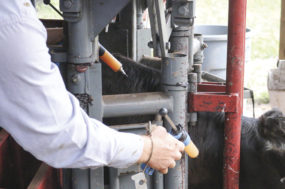Here is a brief look at the news affecting dairy producers during the first week of October 2023:
Digest highlights
- House votes to remove McCarthy as speaker
- California QIP petition forwarded
- October FSA interest rates steady to higher
- All-milk, mailbox price spread dipped in June
- GDT index increases again
- USDA adds $23 million to support DBI
- USDA finds less old-crop corn, soybeans in storage
House votes to remove McCarthy as speaker
The timeline for approval of fiscal year 2024 agricultural program funding and the 2023 Farm Bill faces a new hurdle with the House vote to remove Rep. Kevin McCarthy (R-California) as speaker. Rep. Patrick McHenry (R-North Carolina), chair of the House Financial Services Committee, is serving as acting speaker.
Last weekend, Congress had set a new deadline of Nov. 17 to negotiate appropriations bills that will keep the government operating, including the USDA.
California QIP petition forwarded
On Sept. 20, the California Department of Food and Agriculture (CDFA) referred a petition to terminate the state’s Quota Implementation Plan (QIP) to the Producer Review Board (PRB).
The petition, submitted in June and signed by 25% of California’s dairy producers (243 of 842) producing about 36% of the state’s milk volume, requested immediate termination of the QIP. The PRB is meeting in early October with a limited agenda, so discussion of the petition is likely later in the month.
In 2021, a producer referendum that would have terminated the QIP in 2025 was defeated following a lengthy hearing process.
October FSA interest rates steady to higher
Private lender interest rates on agricultural loans are moving higher and so are rates on loans through the USDA’s Farm Service Agency (FSA). The FSA announced loan interest rates for October 2023. Interest rates for operating and ownership loans (compared to September) are as follows:
- Farm operating loans (direct): 5.25%, up from 5.125%
- Farm ownership loans (direct): 5.25%, up from 5%
- Farm ownership loans (direct, joint financing): 3.25%, up from 3%
- Farm ownership loans (down payment): 1.5%, unchanged
- Emergency Loan (amount of actual loss): 3.75%, unchanged
All-milk, mailbox price spread dipped in June
June 2023 “mailbox” prices averaged about 67 cents per hundredweight (cwt) less than announced average “all-milk” prices for the same month:
- June U.S. all-milk prices averaged $17.90 per cwt, down $1.40 from May 2023. All-milk prices are reported monthly by the USDA National Ag Statistics Service (NASS). The all-milk price is the estimated gross milk price received by dairy producers for all grades and qualities of milk sold to first buyers, before marketing costs and other deductions. The price includes quality, quantity and other premiums, but hauling subsidies are excluded.
- The June 2023 mailbox prices for selected Federal Milk Marketing Orders (FMMOs) averaged $17.23 per cwt, down $1.30 per cwt from May. The mailbox price is the estimated net price received by producers for milk, including all payments received for milk sold and deducting costs associated with marketing. Mailbox prices are reported monthly by the USDA’s Agricultural Marketing Service (AMS) and generally lag all-milk price announcements by a month or more.
GDT index increases again
The Global Dairy Trade (GDT) index posted a third consecutive increase in an auction held Oct. 3. Prices in individual product categories were mostly higher:
- Skim milk powder (SMP) was up 6.6% to $2,558 per metric ton (MT, or about 2,205 pounds).
- Whole milk powder was up 4.8% to $2,931 per MT.
- Anhydrous milkfat was up 3.7% to $4,979 per MT.
- Butter was up 1.3% to $4,806 per MT.
- Cheddar cheese was down 4.8% to $3,853 per MT.
The GDT platform offers dairy products from several global companies: Fonterra (New Zealand), Darigold, Valley Milk and Dairy America (U.S.), Amul (India), Arla (Denmark), Arla Foods Ingredients (Denmark) and Polish Dairy (Poland). The next GDT auction is Oct. 17.
USDA adds $23 million to support DBI
The USDA announced $23 million in awards to support dairy businesses and producers under the Dairy Business Innovation Initiatives (DBI) grant program. The funding supports small and midsized dairy businesses in the development, production, marketing and distribution of dairy products.
Since 2019, the USDA funded 441 projects through the program, coordinated through four regional DBI Initiatives. Dairy farmers and businesses interested in the program must contact the appropriate initiative to be considered for direct technical assistance or a subaward.
USDA finds less old-crop corn, soybeans in storage
With the new-crop harvest well underway in parts of the country, the USDA released its latest quarterly Grain Stocks estimates for last year’s crops. The report also updated 2022 corn silage harvest numbers.
- Old-crop corn stocks in all positions on Sept. 1, 2023, totaled 1.36 billion bushels, down 1% from a year earlier. Of the total stocks, 605 million bushels were stored on farms, up 19% from a year earlier. Off-farm stocks, at 756 million bushels, were down 13%. The June-August 2018 indicated disappearance was estimated at 2.75 billion bushels, compared with 2.99 billion bushels during the same period last year.
- Old-crop soybeans stored in all positions on Sept. 1, 2023, totaled 268 million bushels, down 2% from a year earlier. Soybean stocks stored on farms totaled 72 million bushels, up 14% from a year ago. Off-farm stocks, at 196 million bushels, were down 7% from last September. Indicated disappearance for June-August 2023 totaled 528 million bushels, down 24% from the same period a year earlier.
- U.S. 2022 corn silage production was revised down 291,000 tons, to 128.3 million tons. Area harvested for silage was revised to 6.84 million acres, but the silage yield, at 18.7 tons per acre, remained unchanged from the previous estimate.







